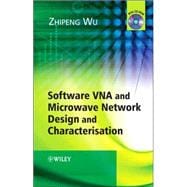
Note: Supplemental materials are not guaranteed with Rental or Used book purchases.
Purchase Benefits
What is included with this book?
| Foreword | |
| Preface | |
| Introduction to Network Analysis of Microwave Circuits | |
| One-Port Network | |
| Total Voltage and Current Analysis | |
| Transmission-Reflection Analysis | |
| Voltage and Current | |
| Reflection Coefficient | |
| Power | |
| Introduction of a 1 and b 1 | |
| Z in Terms of G | |
| Smith Chart | |
| Impedance Chart | |
| Admittance Chart | |
| Terminated Transmission Line | |
| Two-Port Network | |
| Total Quantity Network Parameters | |
| Determination of Z, Y and ABCD Parameters | |
| Properties of Z, Y and ABCD Parameters | |
| Scattering Parameters | |
| Determination of S-parameters | |
| Relation between a and b and Total Voltages and Currents | |
| Power in Terms of a and b | |
| Signal Flow Chart | |
| Properties of S-parameters | |
| Power Flow in a Terminated Two-Port Network | |
| Conversions between Z, Y and ABCD and S-parameters | |
| Single Impedance Two-port Network | |
| S-parameters for Single Series Impedance | |
| S-parameters for Single Shunt Impedance | |
| Two-Port Chart | |
| Single Series Impedance Network | |
| Single Shunt Impedance Network | |
| Scaling Property | |
| Applications of the Two-Port Chart | |
| Identification of Pure Resonance | |
| Q-factor Measurements | |
| Resonance with Power-Dependent Losses | |
| Impedance or Admittance Measurement Using the Two-Port Chart | |
| S-parameters of Common One- and Two-Port Networks | |
| Connected Two-Port Networks | |
| T-Junction | |
| Cascaded Two-Port Networks | |
| Two-Port Networks in Series and Parallel Connections | |
| Scattering Matrix of Microwave Circuits Composed of Multi-port Devices | |
| S-parameters of a Multi-port Device | |
| S-parameters of a Microwave Circuit | |
| Introduction to Software VNA | |
| How to Install | |
| The Software VNA | |
| Stimulus Functions | |
| Parameter Functions | |
| Format Functions | |
| Response Functions | |
| Menu Block | |
| Summary of Unlabelled-key Functions | |
| Preset | |
| Device Under Test (DUT) | |
| Circuit Simulator | |
| Circuit Simulation Procedures and Example | |
| Device Builders and Models | |
| Lossless Transmission Line | |
| One- and Two-Port Standards | |
| Discrete RLC Components: One-Port Impedance Load | |
| Discrete RLC Components: Two-Port Series Impedance | |
| Discrete RLC Components: Two-Port Shunt Admittance | |
| General Transmission Line | |
| Transmission Line Components: Two-Port Serial Transmission Line Stub | |
| Transmission Line Components: Two-Port Parallel Transmission Line Stub | |
| Ideal Two-Port Components: Attenuator/Gain Block | |
| Ideal Two-Port Components: 1:N and N:1 Transformer | |
| Ideal Two-Port Components: Isolator | |
| Ideal Two-Port Components: Gyrator | |
| Ideal Two-Port Components: Circulator | |
| Physical Transmission Lines: Coaxial Line | |
| Physical Transmission Lines: Microstrip Line | |
| Physical Transmission Lines: Stripline | |
| Physical Transmission Lines: Coplanar Waveguide | |
| Physical Transmission Lines: Coplanar Strips | |
| Physical Line Discontinuities: Coaxial Line Discontinuities | |
| Step Discontinuity | |
| Gap Discontinuity | |
| Open-End Discontinuity | |
| Physical Line Discontinuities: Microstrip Line Discontinuities | |
| Step Discontinuity | |
| Gap Discontinuity | |
| Bend Discontinuity | |
| Slit Discontinuity | |
| Open-End Discontinuity | |
| Physical Line Discontinuities: Stripline Discontinuities | |
| Table of Contents provided by Publisher. All Rights Reserved. |
The New copy of this book will include any supplemental materials advertised. Please check the title of the book to determine if it should include any access cards, study guides, lab manuals, CDs, etc.
The Used, Rental and eBook copies of this book are not guaranteed to include any supplemental materials. Typically, only the book itself is included. This is true even if the title states it includes any access cards, study guides, lab manuals, CDs, etc.